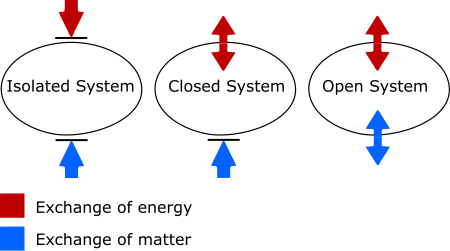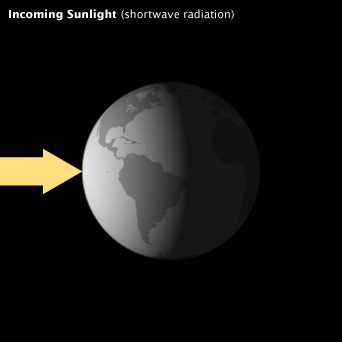AQA Specification focus:
‘Systems concepts and their application to the water and carbon cycles: inputs, outputs, energy, stores/components, flows/transfers, feedback, dynamic equilibrium.’
AQA A-Level Geography explores Earth’s natural systems, particularly the water and carbon cycles, using system concepts to understand how inputs, outputs, and flows interact dynamically.
Understanding Systems in Physical Geography
What is a System?
In physical geography, a system is a set of interrelated components that work together through inputs, outputs, stores, and flows. The water and carbon cycles are examples of open systems, exchanging both energy and matter with their surroundings.
System: A set of interrelated components with inputs, outputs, stores, and flows that function together as a whole.
Geographers analyse these systems to understand how Earth's physical processes interact and respond to change.
Types of Systems
There are three broad types of systems relevant in geography:
Isolated systems: No exchange of matter or energy (e.g., hypothetical models).
Closed systems: Exchange energy but not matter (e.g., the global water cycle in theory).
Open systems: Exchange both energy and matter with their surroundings (e.g., drainage basins or local carbon fluxes).

A comparison of isolated, closed and open systems. Arrows show that isolated systems exchange neither matter nor energy, closed systems exchange only energy, and open systems exchange both matter and energy. Source
Key System Concepts
Inputs and Outputs
Inputs are additions to the system; outputs are removals.
In the water cycle:
Input: Precipitation
Output: Evapotranspiration, runoff
In the carbon cycle:
Input: CO₂ from combustion or respiration
Output: Carbon stored in biomass or sequestered in oceans
Stores/Components
Stores (also called components) are where water or carbon is held. Their size and stability vary over time and space.
Water cycle stores:
Atmosphere (e.g., water vapour)
Cryosphere (e.g., glaciers)
Hydrosphere (e.g., rivers, oceans)
Lithosphere (e.g., groundwater)
Carbon cycle stores:
Atmosphere (CO₂ gas)
Biosphere (living organisms)
Lithosphere (fossil fuels, carbonate rocks)
Hydrosphere (dissolved carbon)
Flows/Transfers
Flows (or transfers) move material between stores. These are critical in understanding system functioning.
Water cycle flows:
Evaporation, condensation, infiltration, percolation, runoff, groundwater flow
Carbon cycle flows:
Photosynthesis, respiration, decomposition, combustion, diffusion (ocean-atmosphere exchange)
Flow (Transfer): The movement of energy or matter between stores in a system.
These flows vary in rate and volume based on both natural and human factors.
Energy in Systems
Both the water and carbon cycles are driven by energy. For example:
Solar energy drives evaporation and photosynthesis.
Geothermal energy contributes to volcanic emissions of carbon.
Energy is the force enabling transfers and maintaining circulation in both cycles.
Systems require inputs and outputs of energy to maintain a dynamic equilibrium.

Incoming short-wave solar radiation (sunlight) entering the Earth system. The arrow represents the energy input that must be balanced by outputs for the system to remain in radiative equilibrium. Source
Feedback Mechanisms
Positive Feedback
Positive feedback amplifies changes, making a system move further from equilibrium.
Example in the carbon cycle:
Rising global temperatures → increased permafrost melt → more methane release → enhanced greenhouse effect → further warming
Example in the water cycle:
Reduced ice cover → lower albedo (reflectivity) → more solar absorption → further melting
Negative Feedback
Negative feedback resists change and helps maintain system balance.
Example in the carbon cycle:
Increased atmospheric CO₂ → enhanced plant growth → more carbon absorbed → atmospheric CO₂ reduced
Example in the water cycle:
More cloud formation → increased albedo → cooling effect → reduced evaporation
Feedback: A response within a system that influences the system’s continued activity; can be positive (amplifying) or negative (stabilising).
Understanding feedback is essential to grasp how these cycles respond to stress and change over time.
Dynamic Equilibrium
Dynamic equilibrium describes a balanced state in a system where inputs and outputs are equal over time, despite fluctuations.
Dynamic Equilibrium: A state of balance within a system where continuous processes occur, but overall conditions remain stable over the long term.
Natural systems rarely remain perfectly balanced. For instance, seasonal changes or extreme events (e.g., floods or droughts) temporarily disturb equilibrium, but over time, systems may return to balance unless significantly altered.
Application to Water and Carbon Cycles
Water Cycle as a System
Inputs: Precipitation from the atmosphere
Stores: Soil moisture, lakes, aquifers, ice
Flows: Surface runoff, throughflow, percolation
Outputs: Evapotranspiration, discharge to oceans
Carbon Cycle as a System
Inputs: Carbon from combustion, respiration, volcanic activity
Stores: Forest biomass, fossil fuels, atmospheric CO₂
Flows: Photosynthesis, ocean uptake, weathering
Outputs: Long-term storage in sediments or ocean sinks
These cycles are interlinked and impacted by human activity. For example, deforestation alters carbon storage and affects water infiltration, disrupting both cycles simultaneously.
Understanding the systems approach allows geographers to interpret how physical processes interact, assess environmental change, and consider sustainability challenges linked to water and carbon management.
FAQ
A system boundary defines the spatial or conceptual limits of a system being studied.
In geography, setting clear boundaries helps determine:
What elements are considered internal (stores and flows)
What is treated as external (inputs and outputs)
For example, in a drainage basin (an open system), the watershed serves as a physical boundary. Defining boundaries ensures clarity in data collection, modelling, and analysis.
Yes. Many features serve dual roles depending on the timescale or perspective.
For example:
A lake acts as a store of water over days or weeks.
But over longer periods, water flowing into and out of it constitutes flows in the system.
This highlights the dynamic and interconnected nature of physical systems, where the role of components can shift depending on the context or scale of analysis.
Both refer to balanced conditions, but they differ in stability and variability.
Steady state equilibrium implies a constant condition without fluctuations.
Dynamic equilibrium allows for regular fluctuations, but the system returns to an overall balance over time.
Most natural systems, like the water and carbon cycles, exist in dynamic equilibrium due to ongoing inputs and outputs that vary seasonally or with events.
Feedback loops determine how a system responds to change:
Negative feedback increases resilience by counteracting change, helping the system return to equilibrium.
Positive feedback can reduce resilience, pushing the system further from its original state and potentially leading to system collapse.
Recognising feedbacks helps geographers anticipate how systems may stabilise or spiral out of control when disturbed by natural or human-induced factors.
Systems concepts allow geographers to simplify complex processes by focusing on inputs, outputs, stores, and flows. This makes it easier to predict how a system may respond to both short-term events (e.g., a storm) and long-term changes (e.g., deforestation).
By identifying feedback loops and dynamic equilibrium, geographers can model how disturbances propagate through a system and assess potential thresholds or tipping points.
This approach supports decision-making in resource management, hazard response, and climate adaptation strategies.
Practice Questions
Define the term dynamic equilibrium and explain how it applies to the carbon cycle. (3 marks)
Mark Scheme:
1 mark for a correct definition:
Dynamic equilibrium is a state of balance within a system where inputs and outputs are equal over time, despite ongoing processes.
1 mark for identifying it applies to a natural system, e.g., the carbon cycle.
1 mark for explaining application:
For example, carbon released through respiration and combustion is balanced by carbon absorbed via photosynthesis and sequestration.
Explain the difference between open and closed systems, and analyse how this distinction helps geographers understand the water and carbon cycles. (6 marks)
Mark Scheme:
1 mark for defining an open system:
A system that exchanges both energy and matter with its surroundings.
1 mark for defining a closed system:
A system that exchanges energy but not matter with its surroundings.
1 mark for applying open system concept to either the water or carbon cycle (e.g., drainage basins or terrestrial carbon fluxes).
1 mark for applying closed system concept at global scale (e.g., the global water cycle as a theoretical closed system).
1 mark for analysis:
Understanding system boundaries helps identify key transfers and storage points, informing how human and natural changes affect system balance.
1 mark for linking to dynamic change:
Identifying that real-world systems are often influenced by external factors, making the open/closed distinction important for assessing impacts.

